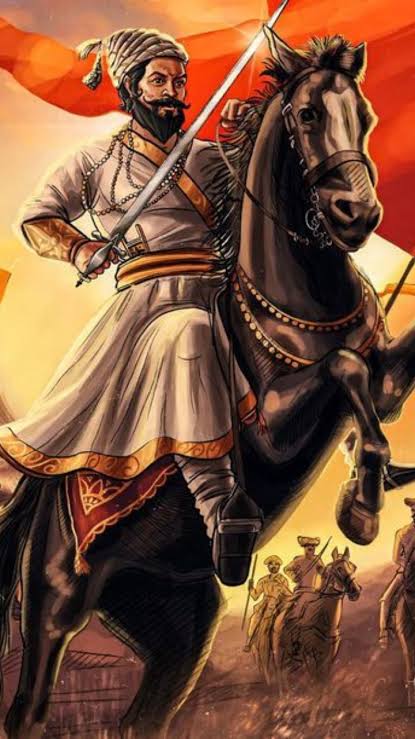Chhatrapati Shivaji Maharaj
one of India’s greatest warriors and the founder of the Maratha Empire, was born on February 19, 1630, in the hill fort of Shivneri, near Pune, Maharashtra. His father, Shahaji Bhosale, was a Maratha general who served the Deccan Sultanates, and his mother, Jijabai, was a devout and strong-willed woman who played a crucial role in shaping Shivaji’s character and values. Shivaji’s life was marked by his unyielding dedication to Swarajya (self-rule), his innovative military tactics, and his profound sense of justice, which earned him the title of Chhatrapati, or “sovereign king.”

Early Life and Influences
Shivaji was deeply influenced by his mother Jijabai, who instilled in him a strong sense of pride in his heritage and a commitment to Hindu values and traditions. As a child, Shivaji was exposed to the epics like the Ramayana and the Mahabharata, which fueled his desire to protect his people and his land. His early education included lessons in martial arts, horse riding, archery, and military tactics, preparing him for the challenges that lay ahead.
Shivaji’s formative years were spent in Pune, where he observed the political dynamics of the region and the growing influence of the Mughal Empire under Emperor Aurangzeb. The decline of the Deccan Sultanates and the increasing oppression of the local population by foreign rulers prompted Shivaji to take up arms to defend his homeland. By the age of 16, Shivaji had already begun his military campaigns, capturing the Torna Fort in 1645, marking the beginning of the Maratha Empire.
Military Prowess and Strategies
Shivaji Maharaj was a master of guerrilla warfare, a tactic that became his signature in battles against the more powerful Mughal forces. His strategy involved swift, surprise attacks on the enemy, utilizing the rugged terrain of the Western Ghats to his advantage. This form of warfare, known as Ganimi Kava, allowed his relatively small army to defeat much larger forces repeatedly.
Shivaji’s military acumen was not limited to guerrilla tactics. He also established a strong naval presence, recognizing the importance of securing the Konkan coast to protect his kingdom from foreign invasions. The creation of a navy was a groundbreaking move in Indian warfare, as it allowed Shivaji to defend the coastline from the Portuguese, Siddis, and other maritime powers.
One of his most significant victories was the capture of the strategically important Kondhana Fort (later renamed Sinhagad) in 1670. The fort, perched atop a steep hill, was a formidable challenge, but Shivaji’s forces, led by his trusted general Tanaji Malusare, managed to scale the fort walls and defeat the Mughal garrison. This victory was emblematic of Shivaji’s indomitable spirit and his ability to inspire loyalty and courage in his followers.
Administration and Governance
Chhatrapati Shivaji Maharaj was not only a brilliant military leader but also an astute administrator. He established a robust and efficient system of governance, which was ahead of its time. His administration was based on the principles of justice, fairness, and welfare of his subjects. He divided his kingdom into several provinces, each governed by a Subedar (governor), ensuring effective control and administration.
Shivaji implemented a progressive tax system that alleviated the burden on farmers and encouraged agriculture. He abolished the jagirdari system, which allowed feudal lords to exploit the peasants, and instead introduced the ryotwari system, where the state directly collected taxes from the farmers. This not only increased the revenue but also ensured that the farmers were not oppressed by middlemen.
Shivaji was also a promoter of religious tolerance. Despite being a devout Hindu, he respected all religions and ensured that his subjects, regardless of their faith, were treated with fairness and justice. His policies reflected a secular outlook, which was unusual in the deeply divided society of his time.
Coronation and LegacyIn
1674, Shivaji Maharaj was formally crowned as the Chhatrapati of the Maratha Kingdom at Raigad Fort. This event was a declaration of sovereignty and a challenge to the Mughal dominance in India. The coronation ceremony was conducted with great pomp, and Shivaji assumed the title of Kshatriya Kulavantas Sinhasanadhishwar Chhatrapati Shivaji Maharaj.
Shivaji’s reign was relatively short, as he passed away on April 3, 1680, at the age of 50. However, his legacy lived on through his descendants and the Maratha Empire, which continued to challenge Mughal authority for decades. Shivaji’s vision of Swarajya and his commitment to the welfare of his people made him a symbol of resistance against oppression.
Conclusion
Chhatrapati Shivaji Maharaj’s life is a testament to the power of vision, courage, and leadership. He laid the foundation for a strong and resilient Maratha Empire that played a crucial role in shaping the history of India. His legacy continues to inspire millions of people, and he remains a revered figure in Indian history, celebrated for his contributions to nation-building, military strategy, and administration. Shivaji Maharaj’s ideals of justice, self-governance, and inclusivity are as relevant today as they were during his time, making him an enduring icon of Indian pride and nationalism.

Get involved!
Comments